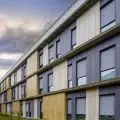The Salt Storehouse has always embodied the dormant potential of Zablocie and Krakow. Until the 19th century, it was economic potential - the area where the Salt Storehouse buildings are located today was a strategic point in the trade of salt, a raw material so important to the local and national economy. With the beginning of the next century, until the outbreak of World War II, the building of the Salt Storehouse was used by the military; first by the Austrian army, and in the interwar period, in turn, by the Polish army, testifying to the military potential of the state. Today, on the other hand, the Salt Storehouse, used by the artistic community, is becoming a symbol of the strength of the local community and the cultural potential of Krakow, and Zablocie in particular. Let the success of the Architectural Hackathon "Let's invent a park around the Salt Storehouse", which took place in the Salt Storehouse on June 8 and 9, 2024, support these words.
25 years from the history of the Salt Depot
In the 1980s, the Salt Depot was a neglected and largely undeveloped site, slowly falling into disrepair. The uncertain future of the historic building and the plot of land it occupied was to be changed by the first artists, who in 1988 linked their activities to them. From then on, the community centered around the Salt Storehouse was constantly growing, enriching the cultural life of Zablocie. The activities of the Storehouse were based on grassroots initiatives, which eventually allowed for the organic formation of a unique place on the scale of the city, where cultural life takes place outside the institutional circuit. The turning point came in 2019, when the entire usable space of the historic building was acquired for the use of the environment of the Salt Storehouse - at that time an exhibition documenting the history of art studios operating in Zabłocie was also organized. The Salt Storehouse is still home to artists, non-governmental organizations, music bands, a recording studio, an old photography studio, a violin-making studio, a music production school and a seasonal boat-building workshop. The Depot has hosted Futurophobic Conventions, and the Sisters of the River collective is expanding its activities. However, black clouds hung over the future of the artistic community centered around the Salt Storehouse from the very beginning of its existence. The premises belonging to the City of Cracow were rented to the community, with the reservation that such a solution would be temporary, as several different investments were planned for the last twenty-five years on the site of the Salt Storehouse. The final decision was made on the Planeta Lem Center for Literature and Language, which would be built according to a design by JEMS architects. However, there is currently no money for the construction, and the initiative itself enjoys less and less public support. The specter of the end of the Salt Storehouse's grassroots activities has instead contributed to further consolidation of the community around it. There was a realization of what a unique phenomenon the Salt Storehouse is, and numerous texts, protests and consultations were held in its defense. The latest chapter in the battle for the Salt Storehouse is the Architecture Hackathon "Let's invent a park around the Salt Storehouse," which produced alternative visions for the development of the space around the Salt Storehouse.
Hackathon at the Salt Storehouse
Photo: Stan Baranski ©Hackathon in the Salt Storehouse
socially designed space
The idea of the Hackathon came about after people connected with the Salt Storehouse visited one of the meetings of the XIII Podgórze District Council. The event was organized by the Salt Storehouse Association, which acted with the support of the district council and Architektura i Biznes magazine. The Architecture Hackathon "Let's invent a park around the Salt Storehouse" was an event divided into three main parts. The first was a public consultation, conducted in the form of a questionnaire filled out by nearly 200 people living in Zablocie and Old Podgórze. The survey asked, among other things, about the functions that the space around the Salt Storehouse should perform and the infrastructure that could be located there. Those who decided to respond mainly pointed to the need to develop the Salt Storehouse plot in the form of a park providing users with access to educational and recreational infrastructure. According to the respondents, a hypothetical park could include a playground, places suitable for outdoor lessons, a creative zone or a brine graduation tower. Along with the expectations of those directly connected with the Salt Storehouse, the results of the survey became part of the guidelines for the main part of the event - the Architectural Hackathon, during which projects for the development of the plot on which the Salt Storehouse is located were to be created. Over the course of two days of hard work, six design groups working under the guidance of mentors Maria Golębiowska and Filip Piwowarczyk created alternative visions of how this unique space in the city could be developed. The results of their joint efforts can be seen at an exhibition, the third part of the Hackathon, which opened on June 15 in the Salt Storehouse.
Hackathon in the Salt Storehouse - Exhibition opening
photo: Stan Baranski ©Hackathon in the Salt Storehouse
fruits of the Hackathon
The groups that signed up for the design portion of the Hackathon were tasked with presenting a vision for the revitalization of the area where the 18th-century warehouse building is located, based on the expectations of the Salt Depot community and the results of a previously conducted survey. The group that applied to participate in the event consisted of people with design experience and professional ties to architecture or landscape architecture. Among the applicants was also a group of four children, who together presented as many as four unique design concepts. The nine-member jury awarded the first prize to the Fourth Design Group, which included Mikhail Bednarz and Nikolai Sazonov, as well as Karolina Górnisiewicz. The project, perversely called "Składowa Part", aimed to create a space that would become a place of coexistence for people living in Zabłocie and Old Podgórze and the artistic community centered around the Salt Storehouse. It was the consideration of the needs of the incumbent community in the Storehouse that became the key to the success of the presented concept. The authors and the author of the "Storehouse Part" assumed the division of the park into several functional zones, such as the Enclave of Silence and Meditation, the Cultural Zone or the Sports and Recreational Space. The infrastructure with which the hypothetical park around the Salt Storehouse was equipped combines the needs of residents and artistic people associated with the Storehouse - those responsible for the project planned both urban community gardens and a dog park there, as well as small architecture intended for exhibition purposes. The various zones of the park were linked to the neighborhood, among other things, thanks to the "Via Saltia" - running through the "Storage Lot", an artery that connects the various functional zones to the Vistula boulevard, making a symbolic reference to the commercial history of the site.
Hackathon at the Salt Depot - Group 4's project - Awarded first place.
Photo: Stan Baranski ©Michał Bednarz, Karolina Górnisiewicz, Mikołaj Sazonov/Hackathon in the Salt Storehouse
The second prize was awarded for the vision of "Salt Park" by Zuzanna Wozowicz and Kacper Gotkowski. The concept takes a slightly more minimalist approach to the subject of revitalizing the Salt Store plot. However, the authors managed to respond to the needs signaled in the questionnaire and the guidelines of the Salt Storehouse community - the "Salt Park" is planned to include a dog run, a brine graduation tower or a separate space for holding workshops. Artistic people operating in the Salt Storehouse, in turn, could count on a shelter with a stage for cultural events and film screenings. Also interesting is the concept of exhibition infrastructure, in which the exhibition locations would correspond to the rhythms of the windows on the Salt Store's facade.
Hackathon at the Salt Storehouse - Group 6's project - Salt Park - Awarded second place
©Zuzanna Wozowicz, Kacper Gotkowski/Hackathon in the Salt Storehouse
The third prize was awarded ex aequo to three project teams. The "Prototype" group , co-created by Patrycja Poręba, Aneta Małek, Anna Węgiel and Konrad Pokrywka, presented a concept that stands out above all for its approach to accessibility and sustainability - the prototype park is about preserving as much vegetation as possible, creating the right conditions for promoting biodiversity and adapting the infrastructure to the needs of people with visual disabilities. Alicja Wąś, Ewelina Tokarz and Wojciech Szafrański, acting as part of Group 2, presented a proposal that emphasized the needs of male and female artists involved in music creation, as well as the implementation of infrastructure to support water management in the park. The last group awarded third place proposed a vision called "Green Corner." Martyna Gwóźdź, Natalia Hadacz and Marcin Kufel planned an environment for the Salt Storehouse, with a wave as its leitmotif. The design took into account the close proximity of the Vistula River, whose waterfront was connected to the Park.
Hackathon at the Salt Storehouse - Projects of Group 5 - Children - Awarded 1st Special Prize.
Photo: Stan Baranski ©Alicja Lasota, Łucja Lasota, Kosma Dzierżak, Ignacy Dziurdzia/Hackathon in the Salt Storehouse
The work of the fifth group, which included Lucja and Alicja Lasota, as well as Kosma Dzierżak and Ignacy Dziurdzia, deserves special attention. The children's voice for the Salt Storehouse presented as many as four concepts, unique in the competition, which included plans for recreational water tanks, a climbing wall and a strawberry field. There was no shortage of symbolic references to the events of activity taking place around the Salt Storehouse - one of the designers proposed decorating the buildings with sculptures reminiscent of the activities of the Sisters of the River collective and the organization of the Futurophobic Convention.
Hackathon at the Salt Warehouse
Photo credit: Stan Baranski ©Hackathon at the Salt Warehouse
need for discussion
As a direct result of the activities that took place as part of the Architecture Hackathon, a group of projects was created that reflect the needs of the community that ties its activities around the Salt Warehouse and those living in Zabłocie and Old Podgórze. However, the course and results of the Hackathon can be seen in a much broader perspective - the unquestionable success of the initiative is not only a testament to the strength of the Salt Storehouse environment and the creative potential of those involved in design in Krakow, but also to the need to engage local communities in discussions that concern the future of the spaces they use. It is their voice that should be one of the basic determinants taken into account when planning urban investments.























































































